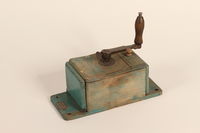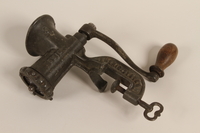Overview
- Brief Narrative
- Metal measuring scale with two trays, of the type used in the Łódź Ghetto in German-occupied Poland from May 1940 to August 1944. Łódź was occupied by Germany a week after the September 1, 1939, invasion of Poland. The city was renamed Litzmannstadt, and in February 1940, approximately 160,000 people from the Jewish population were confined to a small, closed ghetto. All residents had to work, and many became forced laborers in ghetto factories. Eventually, nearly 100 factories were in operation. The major ones produced textiles, including uniforms for the Germany Army. Due to the severe overcrowding and scarcity of food, disease and starvation were common. The Judenrat (Jewish Council) were forced to administer the ghetto for the Germans. Judenrat chairman, Mordechai Rumkowski, thought hard work and increased manufacturing output would preserve the ghetto, but in January 1942, mass deportations to Chelmno killing center began. By the end of the year, half of the residents were murdered. In summer 1944, Łódź, the last ghetto in Poland, was destroyed, and the remaining Jews were sent to Chelmno and Auschwitz-Birkenau killing centers.
- Date
-
use:
approximately 1900-approximately 1945
- Geography
-
use:
Poland.
- Credit Line
- United States Holocaust Memorial Museum Collection
Physical Details
- Classification
-
Tools and Equipment
- Category
-
Measuring instruments
- Object Type
-
Trip scales (aat)
- Genre/Form
- Scales.
- Physical Description
- Metal balance scale with two circular weighing pans. The frame has four, small metal feet with three decorative horizontal bars, with remnants of yellow paint, spanning between them on the front and back. The lower bar is straight with geometric shapes spaced across it, the middle bar curves downwards around a circular piece in the center, and the top bar is thin and straight. Spanning the upper bars is a metal piece with rounded ends that connects to a horizontal, pivoting framework with brackets on each end for holding the circular pans in place. From the center of the piece, extending upward, is a thin, pointed needle with measuring lines etched on the surface. Attached to the back of the frame, bent at a 90 degree angle, and then extending upward so it rests directly behind the center needle, is a second flat, pointed needle with a circular opening towards the top. The metal weighing pans are a silver-colored metal with a flat bottom and rimmed top. The left pan is approximately 1.500 inches deep, and the right pan is approximately 2.250 inches deep and has a pointed spout on the side. The surface of the scale is severely rusted, and there is significant paint loss.
- Dimensions
- overall: Height: 12.000 inches (30.48 cm) | Width: 20.500 inches (52.07 cm) | Depth: 8.500 inches (21.59 cm)
- Materials
- overall : metal, paint
Rights & Restrictions
- Conditions on Access
- No restrictions on access
- Conditions on Use
- No restrictions on use
Keywords & Subjects
Administrative Notes
- Legal Status
- Permanent Collection
- Provenance
- The scale was acquired by the United States Holocaust Memorial Museum in 1990.
- Record last modified:
- 2023-06-14 07:09:17
- This page:
- https://collections.ushmm.org/search/catalog/irn4111
Download & Licensing
In-Person Research
- By Appointment
- Request 21 Days in Advance of Visit
- Plan a Research Visit
- Request to See This Object
Contact Us
Also in Krakow, Poland collection
The collection consists of clothing irons, a coffee mill, a meat grinder, and a scale relating to Krakow, Poland before and during the Holocaust.
Date: approximately 1900-approximately 1945

Manual hanging hand crank coffee mill
Object
Wooden, wall hanging, coffee mill of the type used in the Łódź Ghetto in German-occupied Poland from May 1940 to August 1944. Łódź was occupied by Germany a week after the September 1, 1939, invasion of Poland. The city was renamed Litzmannstadt, and in February 1940, approximately 160,000 people from the Jewish population were confined to a small, closed ghetto. All residents had to work, and many became forced laborers in ghetto factories. Eventually, nearly 100 factories were in operation. The major ones produced textiles, including uniforms for the Germany Army. In the ghetto, people attempted to maintain their normal lives, despite the increasing hardships. Women, when they were not laboring in the factories, worked to prepare food and do laundry for their families. These activities were made difficult by the meager food rations they received, and the lack of running water throughout most of the ghetto. Due to the severe overcrowding and scarce food, disease and starvation were common. The Judenrat (Jewish Council) were forced to administer the ghetto for the Germans. Judenrat chairman, Mordechai Rumkowski, thought hard work and increased manufacturing output would preserve the ghetto, but in January 1942, mass deportations to Chelmno killing center began. By the end of the year, half of the residents were murdered. In summer 1944, Łódź, the last ghetto in Poland, was destroyed, and the remaining Jews were sent to Chelmno and Auschwitz-Birkenau killing centers.

Manual hand crank meat grinder
Object
Manual hand-crank meat grinder of the type used in the Łódź Ghetto in German-occupied Poland from May 1940 to August 1944. Łódź was occupied by Germany a week after the September 1, 1939, invasion of Poland. The city was renamed Litzmannstadt, and in February 1940, approximately 160,000 people from the Jewish population were confined to a small, closed ghetto. All residents had to work, and many became forced laborers in ghetto factories. Eventually, nearly 100 factories were in operation. The major ones produced textiles, including uniforms for the Germany Army. In the ghetto, people attempted to maintain their normal lives, despite the increasing hardships. Women, when they were not laboring in the factories, worked to prepare food and do laundry for their families. These activities were made difficult by the meager food rations they received, and the lack of running water throughout most of the ghetto. Due to the severe overcrowding and scarce food, disease and starvation were common. The Judenrat (Jewish Council) were forced to administer the ghetto for the Germans. Judenrat chairman, Mordechai Rumkowski, thought hard work and increased manufacturing output would preserve the ghetto, but in January 1942, mass deportations to Chelmno killing center began. By the end of the year, half of the residents were murdered. In summer 1944, Łódź, the last ghetto in Poland, was destroyed, and the remaining Jews were sent to Chelmno and Auschwitz-Birkenau killing centers.
Cast metal charcoal iron with a wooden handle
Object
Cast metal charcoal iron of the type used in the Łódź Ghetto in German-occupied Poland from May 1940 to August 1944. Łódź was occupied by Germany a week after the September 1, 1939, invasion of Poland. The city was renamed Litzmannstadt, and in February 1940, approximately 160,000 people from the Jewish population were confined to a small, closed ghetto. All residents had to work, and many became forced laborers in ghetto factories. Eventually, nearly 100 factories were in operation. The major ones produced textiles, including uniforms for the Germany Army. In the ghetto, people attempted to maintain their normal lives, despite the increasing hardships. Women, when they were not laboring in the factories, worked to prepare food and do laundry for their families. These activities were made difficult by the meager food rations they received, and the lack of running water throughout most of the ghetto. Due to the severe overcrowding and scarce food, disease and starvation were common. The Judenrat (Jewish Council) were forced to administer the ghetto for the Germans. Judenrat chairman, Mordechai Rumkowski, thought hard work and increased manufacturing output would preserve the ghetto, but in January 1942, mass deportations to Chelmno killing center began. By the end of the year, half of the residents were murdered. In summer 1944, Łódź, the last ghetto in Poland, was destroyed, and the remaining Jews were sent to Chelmno and Auschwitz-Birkenau killing centers.
Cast metal chimney iron with a wooden handle
Object
Cast metal chimney iron of the type used in the Łódź Ghetto in German-occupied Poland from May 1940 to August 1944. Łódź was occupied by Germany a week after the September 1, 1939, invasion of Poland. The city was renamed Litzmannstadt, and in February 1940, approximately 160,000 people from the Jewish population were confined to a small, closed ghetto. All residents had to work, and many became forced laborers in ghetto factories. Eventually, nearly 100 factories were in operation. The major ones produced textiles, including uniforms for the Germany Army. In the ghetto, people attempted to maintain their normal lives, despite the increasing hardships. Women, when they were not laboring in the factories, worked to prepare food and do laundry for their families. These activities were made difficult by the meager food rations they received, and the lack of running water throughout most of the ghetto. Due to the severe overcrowding and scarce food, disease and starvation were common. The Judenrat (Jewish Council) were forced to administer the ghetto for the Germans. Judenrat chairman, Mordechai Rumkowski, thought hard work and increased manufacturing output would preserve the ghetto, but in January 1942, mass deportations to Chelmno killing center began. By the end of the year, half of the residents were murdered. In summer 1944, Łódź, the last ghetto in Poland, was destroyed, and the remaining Jews were sent to Chelmno and Auschwitz-Birkenau killing centers.
Cast metal charcoal iron with hinged top and wooden handle
Object
Cast metal charcoal iron of the type used in the Łódź Ghetto in German-occupied Poland from May 1940 to August 1944. Łódź was occupied by Germany a week after the September 1, 1939, invasion of Poland. The city was renamed Litzmannstadt, and in February 1940, approximately 160,000 people from the Jewish population were confined to a small, closed ghetto. All residents had to work, and many became forced laborers in ghetto factories. Eventually, nearly 100 factories were in operation. The major ones produced textiles, including uniforms for the Germany Army. In the ghetto, people attempted to maintain their normal lives, despite the increasing hardships. Women, when they were not laboring in the factories, worked to prepare food and do laundry for their families. These activities were made difficult by the meager food rations they received, and the lack of running water throughout most of the ghetto. Due to the severe overcrowding and scarce food, disease and starvation were common. The Judenrat (Jewish Council) were forced to administer the ghetto for the Germans. Judenrat chairman, Mordechai Rumkowski, thought hard work and increased manufacturing output would preserve the ghetto, but in January 1942, mass deportations to Chelmno killing center began. By the end of the year, half of the residents were murdered. In summer 1944, Łódź, the last ghetto in Poland, was destroyed, and the remaining Jews were sent to Chelmno and Auschwitz-Birkenau killing centers.



